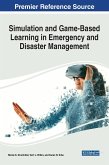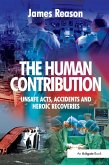Healthcare Analytics
Emergency Preparedness for COVID-19
Herausgeber: Rafalski, Edward M.; Mullner, Ross M.
Healthcare Analytics
Emergency Preparedness for COVID-19
Herausgeber: Rafalski, Edward M.; Mullner, Ross M.
- Gebundenes Buch
- Merkliste
- Auf die Merkliste
- Bewerten Bewerten
- Teilen
- Produkt teilen
- Produkterinnerung
- Produkterinnerung
This book addresses a compelling need for documenting what has been learned by the academic and professional healthcare communities in healthcare analytics and disaster preparedness to this point in the COVID-19 pandemic.
Andere Kunden interessierten sich auch für
![Emergency Management and Disaster Response Utilizing Public-Private Partnerships Emergency Management and Disaster Response Utilizing Public-Private Partnerships]() Emergency Management and Disaster Response Utilizing Public-Private Partnerships184,99 €
Emergency Management and Disaster Response Utilizing Public-Private Partnerships184,99 €![Simulation and Game-Based Learning in Emergency and Disaster Management Simulation and Game-Based Learning in Emergency and Disaster Management]() Simulation and Game-Based Learning in Emergency and Disaster Management193,99 €
Simulation and Game-Based Learning in Emergency and Disaster Management193,99 €![Data Analytics Data Analytics]() Adedeji B. BadiruData Analytics212,99 €
Adedeji B. BadiruData Analytics212,99 €![Big Data Analytics and Intelligent Techniques for Smart Cities Big Data Analytics and Intelligent Techniques for Smart Cities]() Big Data Analytics and Intelligent Techniques for Smart Cities149,99 €
Big Data Analytics and Intelligent Techniques for Smart Cities149,99 €![Social Data Analytics in the Cloud with AI Social Data Analytics in the Cloud with AI]() Xuebin WeiSocial Data Analytics in the Cloud with AI107,99 €
Xuebin WeiSocial Data Analytics in the Cloud with AI107,99 €![The Human Contribution The Human Contribution]() James ReasonThe Human Contribution168,99 €
James ReasonThe Human Contribution168,99 €![Nanomaterial-based Sensors for Healthcare Application Nanomaterial-based Sensors for Healthcare Application]() Nanomaterial-based Sensors for Healthcare Application151,99 €
Nanomaterial-based Sensors for Healthcare Application151,99 €-
-
-
This book addresses a compelling need for documenting what has been learned by the academic and professional healthcare communities in healthcare analytics and disaster preparedness to this point in the COVID-19 pandemic.
Produktdetails
- Produktdetails
- Verlag: CRC Press
- Seitenzahl: 306
- Erscheinungstermin: 9. August 2022
- Englisch
- Abmessung: 240mm x 161mm x 21mm
- Gewicht: 625g
- ISBN-13: 9781032068459
- ISBN-10: 1032068450
- Artikelnr.: 63656529
- Herstellerkennzeichnung
- Libri GmbH
- Europaallee 1
- 36244 Bad Hersfeld
- gpsr@libri.de
- Verlag: CRC Press
- Seitenzahl: 306
- Erscheinungstermin: 9. August 2022
- Englisch
- Abmessung: 240mm x 161mm x 21mm
- Gewicht: 625g
- ISBN-13: 9781032068459
- ISBN-10: 1032068450
- Artikelnr.: 63656529
- Herstellerkennzeichnung
- Libri GmbH
- Europaallee 1
- 36244 Bad Hersfeld
- gpsr@libri.de
Edward M. Rafalski is Adjunct Assistant Professor at University of Illinois School of Public Health, and an Affiliate Associate Professor at the University of South Florida, College of Public Health. He holds qualifications from the University of Chicago and Yale University School of Public Health.
Introduction
Edward M. Rafalski I. Section 1
Epidemiology and analytics 1. What is a pandemic, an epidemic?
Jonathan A. McCullers 2. A brief history of pandemics
Jonathan A. McCullers 3. Health care continuum
Edward M. Rafalski 4. The fog of war and data
Edward M. Rafalski 5. Sources of data/modeling
Edward M. Rafalski and Robert Marksthaler 6. Quantifying and responding to COVID's financial and operational impact
Mark Grube and Rob Fromberg II. Section 2
State case studies 7. Measuring and addressing healthcare employee well
being in an Alabama health system during COVID
19
Katherine A. Meese et al. 8. Colorado state case study
Adom Netsanet et al. 9. Case study: A Florida COVID
19 dashboard
Zachary Pruitt et al. 10. State case study: Illinois
Helen Margellos
Anast et al. 11. Tennessee case study
Cori Cohen Grant et al. 12. Regional modeling
Madeleine McDowell et al. III. Section 3
Topics 13. Healthcare analytics: The effects of the pandemic on behavioral health
Kasey Knopp and Naakesh (Nick) Dewan 14. Digital transformation in healthcare: How COVID
19 was an agent for rapid change
Bala Hota and Omar Lateef 15. Telehealth
Richard Fine 16. The COVID
19 pandemic and development of drugs and vaccinations
Pradeep S. B. Podila 16. Value of health information exchanges to support public health reporting
Pradeep S. B. Podila Conclusion
Edward M. Rafalski and Ross M. Mullner Epilogue
Edward M. Rafalski
Edward M. Rafalski I. Section 1
Epidemiology and analytics 1. What is a pandemic, an epidemic?
Jonathan A. McCullers 2. A brief history of pandemics
Jonathan A. McCullers 3. Health care continuum
Edward M. Rafalski 4. The fog of war and data
Edward M. Rafalski 5. Sources of data/modeling
Edward M. Rafalski and Robert Marksthaler 6. Quantifying and responding to COVID's financial and operational impact
Mark Grube and Rob Fromberg II. Section 2
State case studies 7. Measuring and addressing healthcare employee well
being in an Alabama health system during COVID
19
Katherine A. Meese et al. 8. Colorado state case study
Adom Netsanet et al. 9. Case study: A Florida COVID
19 dashboard
Zachary Pruitt et al. 10. State case study: Illinois
Helen Margellos
Anast et al. 11. Tennessee case study
Cori Cohen Grant et al. 12. Regional modeling
Madeleine McDowell et al. III. Section 3
Topics 13. Healthcare analytics: The effects of the pandemic on behavioral health
Kasey Knopp and Naakesh (Nick) Dewan 14. Digital transformation in healthcare: How COVID
19 was an agent for rapid change
Bala Hota and Omar Lateef 15. Telehealth
Richard Fine 16. The COVID
19 pandemic and development of drugs and vaccinations
Pradeep S. B. Podila 16. Value of health information exchanges to support public health reporting
Pradeep S. B. Podila Conclusion
Edward M. Rafalski and Ross M. Mullner Epilogue
Edward M. Rafalski
Introduction
Edward M. Rafalski I. Section 1
Epidemiology and analytics 1. What is a pandemic, an epidemic?
Jonathan A. McCullers 2. A brief history of pandemics
Jonathan A. McCullers 3. Health care continuum
Edward M. Rafalski 4. The fog of war and data
Edward M. Rafalski 5. Sources of data/modeling
Edward M. Rafalski and Robert Marksthaler 6. Quantifying and responding to COVID's financial and operational impact
Mark Grube and Rob Fromberg II. Section 2
State case studies 7. Measuring and addressing healthcare employee well
being in an Alabama health system during COVID
19
Katherine A. Meese et al. 8. Colorado state case study
Adom Netsanet et al. 9. Case study: A Florida COVID
19 dashboard
Zachary Pruitt et al. 10. State case study: Illinois
Helen Margellos
Anast et al. 11. Tennessee case study
Cori Cohen Grant et al. 12. Regional modeling
Madeleine McDowell et al. III. Section 3
Topics 13. Healthcare analytics: The effects of the pandemic on behavioral health
Kasey Knopp and Naakesh (Nick) Dewan 14. Digital transformation in healthcare: How COVID
19 was an agent for rapid change
Bala Hota and Omar Lateef 15. Telehealth
Richard Fine 16. The COVID
19 pandemic and development of drugs and vaccinations
Pradeep S. B. Podila 16. Value of health information exchanges to support public health reporting
Pradeep S. B. Podila Conclusion
Edward M. Rafalski and Ross M. Mullner Epilogue
Edward M. Rafalski
Edward M. Rafalski I. Section 1
Epidemiology and analytics 1. What is a pandemic, an epidemic?
Jonathan A. McCullers 2. A brief history of pandemics
Jonathan A. McCullers 3. Health care continuum
Edward M. Rafalski 4. The fog of war and data
Edward M. Rafalski 5. Sources of data/modeling
Edward M. Rafalski and Robert Marksthaler 6. Quantifying and responding to COVID's financial and operational impact
Mark Grube and Rob Fromberg II. Section 2
State case studies 7. Measuring and addressing healthcare employee well
being in an Alabama health system during COVID
19
Katherine A. Meese et al. 8. Colorado state case study
Adom Netsanet et al. 9. Case study: A Florida COVID
19 dashboard
Zachary Pruitt et al. 10. State case study: Illinois
Helen Margellos
Anast et al. 11. Tennessee case study
Cori Cohen Grant et al. 12. Regional modeling
Madeleine McDowell et al. III. Section 3
Topics 13. Healthcare analytics: The effects of the pandemic on behavioral health
Kasey Knopp and Naakesh (Nick) Dewan 14. Digital transformation in healthcare: How COVID
19 was an agent for rapid change
Bala Hota and Omar Lateef 15. Telehealth
Richard Fine 16. The COVID
19 pandemic and development of drugs and vaccinations
Pradeep S. B. Podila 16. Value of health information exchanges to support public health reporting
Pradeep S. B. Podila Conclusion
Edward M. Rafalski and Ross M. Mullner Epilogue
Edward M. Rafalski








